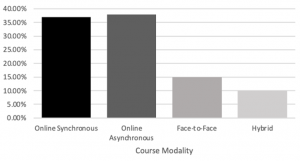By Lauren Sweeney
Student learning has been affected by COVID-19. Liberal Arts undergraduate student Laurent Sweeney conducted research examining student perceptions of different courses modalities during the pandemic.
Prior to COVID-19, online courses were typically self-paced, allowing students to choose their own schedule and not including the real-time interactive elements of synchronous courses. Before the pandemic, most classes were held face-to-face, but since then, nearly all classes were moved to an online format. Given all of these changes, many open questions remain about student attitudes toward different course modalities during the time of COVID-19.
With the support of her faculty advisor, Dr. Katherine Warnell in the department of Psychology, Ms. Sweeney designed an online survey that included measures of learning preferences, attention to different course modalities, general attitudes about effects of COVID on campuses, and measures of nervousness about returning to in-person campus life. The study included measures of personality and social support and surveyed 598 undergraduates in the Intro to Psychology classes of the Fall 2021 semester in order to gain a more nuanced understanding of student attitudes and correlates of those attitudes.

Figure 1: Students’ Favorite Course Formats
The majority of students (53.2%) chose face-to-face as their most preferred format, although some students (15.0%) did rate face-to-face as their least preferred. We found significant effects of conscientiousness (F(3,590) = 4.61, p = .003) and social support (F(3,590) = .3.15, p = .025). People who were more satisfied with their social support system, i.e. friends and family, were more likely to have a higher score of conscientiousness. We also found that those who preferred face-to-face classes had the highest levels of conscientiousness and social support. Conscientiousness is one of five traits in the Five Factor Model and refers to being careful or diligent. Social support refers to how many people the participant indicated as being able to provide support to them, and how satisfied they were with the support given. Contrary to some past work, we did not find an effect of extraversion (F(3,590) = 2.14, p = .52).
In the free-response portion of the survey, students who preferred online formats tended to comment on how much time it saved to not commute to campus and how it was more comfortable to attend classes from home. Those who preferred asynchronous online liked the ability to work at their own pace. Students who preferred face-to-face and hybrid mentioned learning better, finding it easier to pay attention, getting to socialize, and being able to ask questions.

Figure 2: Students’ Least Favorite Course Formats
Overall, the least favored course format was online asynchronous (38%), but online synchronous was a close second (37%). Face-to-face was next (15%), and then hybrid (10%). While the online formats were the least favored, it is also important to note that some participants favored face-to-face and hybrid the least.
Students who disliked synchronous online reported not enjoying learning on Zoom because it was distracting and hard to pay attention. Just as students endorsed online asynchronous because it was self-paced, those who disliked it singled out the difficulty of pacing themselves and staying on track, as well as the lack of interaction. Those who disliked face-to-face, and hybrid noted the scheduling and commuting issues of having to attend class on campus. Some students also noted social anxiety in the classroom.
Figure 3: Student Judgements about Impact of COVID on Campus Life
| Strongly Disagree | Somewhat Disagree | Neither Agree nor Disagree | Somewhat Agree | Strongly Agree | |
| Online classes have a negative impact on my learning | 12.2% | 14.2% | 25.2% | 24.3% | 24.2% |
| Online classes have a positive impact on my grades | 18% | 15.5% | 27.5% | 25.1% | 13.8% |
| My mood is more positive this semester than last year | 10.1% | 15.7% | 26% | 27% | 21.2% |
| I feel like I am having a normal college experience | 8.8% | 12.8% | 17.5% | 40.3% | 20.6% |
| I am feeling social anxiety in my face-to-face classes | 22.1% | 19.4% | 19.7% | 25.8% | 13% |
| I find it easier to pay attention to recorded lectures than face-to-face lectures | 39.1% | 19.5% | 19.3% | 14% | 8.1% |
There was more variability on questions about the effects of online courses, and more overall agreement about resuming in-person campus life. For example, when asked about a negative impact on learning, or a positive impact on grades, the scores were evenly distributed. This displays how every student’s experience is different, and the transition to online classes may have been harder or easier for some. Over half of the participants agreed that they were having a normal college experience, despite the pandemic, and most participants found it easier to pay attention in a face-to-face lecture rather than a recorded lecture.
There are several practical implications of these research findings. For example, increased attention during face-to-face formats (e.g., less checking of one’s phone) suggests that professors and students might benefit from taking a short break or two during lectures, particularly in synchronous online formats.
This study has the prospect of improving student academic success, well-being, and overall learning experiences. These results have relevance for student experiences in higher education in the current academic environment and in future years. Continuing to study student preferences is important because the higher education landscape may never be the same in a COVID-19 or post-pandemic world. Adapting to these new formats and expectations can help ensure student learning and success.
